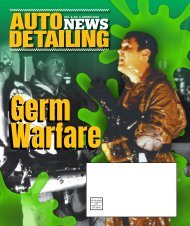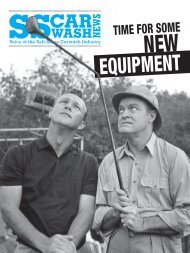Create successful ePaper yourself
Turn your PDF publications into a flip-book with our unique Google optimized e-Paper software.
INDUSTRY NEWS<br />
Are your employees ‘cool’ according to OSHA?<br />
OSHA initiated the Small Business<br />
Regulatory Enforcement Fairness Act<br />
(SBREFA) process on June 20, <strong>2023</strong>.<br />
This next step in the rulemaking process<br />
will include the convening of a Small<br />
Business Advocacy Review (SBAR) panel<br />
to gain input from small entity representatives<br />
(SERs) on the potential impacts<br />
of a heat-specific standard. More<br />
information on the Heat Injury and Illness<br />
SBREFA can be found at: https://<br />
www.osha.gov/heat/sbrefa.<br />
For more information on how to engage<br />
with this stage of the rulemaking<br />
process, visit: https://www.osha.gov/lawsregs/rulemakingprocess#tab2.<br />
Advance Notice<br />
of Proposed Rulemaking<br />
On October 27, 2021, OSHA (Occupational<br />
Safety and Health Administration)<br />
published an Advance Notice<br />
of Proposed Rulemaking (ANPRM) for<br />
Heat Injury and Illness Prevention in<br />
Outdoor and Indoor Work Settings in the<br />
Federal Register, according to OSHA.<br />
gov. With this publication, OSHA has<br />
begun the rulemaking process to consider<br />
a heat-specific workplace standard. A<br />
standard specific to heat-related injury<br />
and illness prevention would more clearly<br />
set forth employer obligations and the<br />
measures necessary to more effectively<br />
protect employees from hazardous heat.<br />
The ultimate goal is to prevent and reduce<br />
the number of occupational injuries,<br />
illnesses, and fatalities caused by<br />
exposure to hazardous heat.<br />
The publication of the ANPRM initiated<br />
a public comment period allowing<br />
OSHA to gather information, diverse perspectives<br />
and technical expertise on issues<br />
that might be considered in developing a<br />
heat standard. These issues include the<br />
scope of a standard, heat stress thresholds<br />
for workers across various industries, heat<br />
acclimatization planning, and heat exposure<br />
monitoring, as well as the nature,<br />
types, and effectiveness of controls that<br />
may be required as part of a standard.<br />
The publication of this ANPRM has<br />
no impact on OSHA's current enforcement<br />
policies. The ANPRM is available<br />
on the Federal Register <strong>web</strong> page and at<br />
www.regulations.gov, which is the Federal<br />
e-Rulemaking Portal.<br />
The comment period closed on January<br />
26, 2022. OSHA received 965 unique<br />
comments from stakeholders, which are<br />
available at www.regulations.gov/document/OSHA-2021-0009-0001.<br />
According to OSHA: Heat is the leading<br />
weather-related killer, and it is becoming more dangerous<br />
as 18 of the last 19 years were the hottest<br />
on record. Excessive heat can cause heat stroke and<br />
even death if not treated properly. It also exacerbates<br />
existing health problems like asthma, kidney<br />
failure, and heart disease. Workers in agriculture<br />
and construction are at highest risk, but the problem<br />
affects all workers exposed to heat, including indoor<br />
workers without climate-controlled environments.<br />
Essential jobs where employees are exposed to high<br />
levels of heat are disproportionately held by Black<br />
and Brown workers.<br />
Heat stress killed 815 US workers and seriously<br />
injured more than 70,000 workers from<br />
1992 through 2017, according to the Bureau of<br />
Labor Statistics. However, this is likely a vast<br />
underestimate, given that injuries and illnesses are<br />
underreported in the US, especially in the sectors<br />
employing vulnerable and often undocumented<br />
workers. Further, heat is not always recognized as<br />
a cause of heat-induced injuries or deaths and can<br />
easily be misclassified, because many of the symptoms<br />
overlap with other more common diagnoses.<br />
To date, California, Washington, Minnesota,<br />
and the US military have issued heat protections.<br />
OSHA currently relies on the general duty<br />
One System, Two Great Coating Options<br />
The EPIC® PRO Ceramic Coating System offers a superior high-gloss, hydrophobic finish, abrasion resistance,<br />
and enhanced UV protection. Now available in two coating options. EPIC® PRO+ Ceramic Coating with Graphene<br />
offers a 4 year / 48,000 mile warranty, and EPIC® PRO Ceramic Coating offers a 3 year / 36,000 mile warranty.<br />
• Easy-to-apply coatings<br />
• Bonds with the clear coat for outstanding depth of gloss<br />
• Produces the ultimate “wet” look<br />
• Excellent hydrophobic properties allow water and dirt to slide off<br />
Visit MalcoAutomotive.com or contact your distributor today, to purchase EPIC PRO+ Ceramic Coating with Graphene or EPIC PRO Cereamic Coating.<br />
SURFACE CORRECTION | SURFACE PROTECTION | DRESSINGS | INTERIOR CLEANING | EXTERIOR CLEANING<br />
@Malcoautomotive @Malcoautomotive Malcoautomotive<br />
www.malcoautomotive.com<br />
14 | AUTO DETAILING NEWS | VOL. 8, NO. 3 • FALL <strong>2023</strong>
















